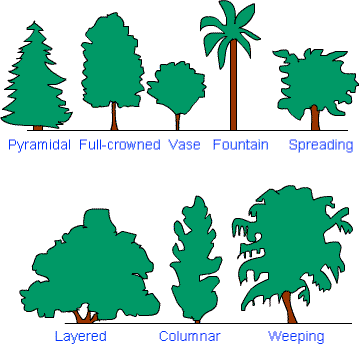Forests - Our Lifeline Class 7 Notes Science Chapter 12
FOREST

An area with high density of trees is called a forest. A forest is a system which is composed of plants, animals and microorganisms.
Forest as Habitat:
Forest is the habitat for a variety of living beings. Many plants, animals and microbes live in the forest.
A typical tree forest is composed of two distinct layers, viz. overstory ( or canopy) and understory. A tree can be divided into two parts: trunk and branches. The branches of a tree make its crown.
Crowns of several trees; in the forest; make the canopy. In dense forests, the canopy looks like the roof of the forest. There are many animals and creatures which live only on the canopy, e.g. monkeys.
Crowns of trees come in various shapes. Some common examples are shown in the given figure.
 Fig: Types of trees
Fig: Types of trees
The lower layer of the forest is called understory. It is composed of herbs and shrubs. The understory is a different world in itself. The understory may not get proper sunlight in dense forests.
There are many animals and creatures which live only in the understory of a forest.
Review Questions
Ques 1 - What is forest?
Answer:An area with dense cover of trees is called forest.
Ques 2 - What is overstory in a forest?
Answer:The upper leafy portion of a forest is called overstory.
Important Forest Produce: Many important forest produce are useful for us. Some examples are given below:
Firewood and dry leaves are used as kitchen fuel in villages which are close to a forest.
Timber is an important raw material; for construction activities and for making furniture and artifacts.
Wood pulp is used in manufacturing paper.
Honey, kendu leaves, catechu, lac, raisin, etc. are important forest produce.
Many medicinal plants and herbs are found in forests.
Forest as a System:
Every part of the forest contributes in making a self-sustaining system. The green plants prepare food through photosynthesis. The herbivores directly take food from the green plants. The carnivores take food from the herbivores. This makes a food chain, which can be shown by following example:
Grass → Deer → Lion
When an animal or a plant dies, its dead remains rot in due course of time and turn into soil-like thing. The process is called decomposition and microorganisms carry out this process. Decomposition is the process by which all the raw materials are returned to the nature. The soil-like thing made after decomposition is called humus. It makes the soil highly fertile. The topsoil of forest is fertile because of presence of humus.
Role of Forest in Preserving the Environment: Forest plays an important role in preserving the environment. Green plants take solar energy and convert it into chemical energy while making food. Thus, solar energy is transferred to other living beings through the green plants. Green plants utilize carbon dioxide during photosynthesis and release oxygen. That is how the green plants maintain the balance of carbon dioxide and oxygen in the environment.
Role of Forest in Water Cycle:The roots of the trees make the soil porous. Rainwater seeps through these pores and recharge groundwater. Forests prevent wastage of rainwater in the form of runoff. Forests also prevent flash floods by slowing down the movement of water.
Role of Forest in Soil Conservation:The roots of the trees hold the topsoil in place. This prevents soil erosion by wind or by running water.
Deforestation and its Effect: Large scale cutting of trees to clear land for human use is called deforestation. Due to growing human population, vast tracts of forest have been removed. This has created many problems. Some of them are given below:
- Reduced forest cover has led to soil erosion and loss of soil fertility at many places.
- Reduced forest cover has disturbed the natural process of recharging of groundwater. This has resulted in shortage of drinking water at many places.
- Reduced forest cover means there is loss of habitat for many animals. Existence of most of the animals is in danger because of this.
- Reduced forest cover means there is higher percentage of carbon dioxide in the atmosphere. This is leading to global warming. The average temperature of the earth is on the rise.
Review Questions:
Ques 1 - What do you understand by deforestation?
Answer:Large scale cutting of trees to clear land for human use is called deforestation.
Ques 2 - What is humus?
Answer:The part of the topsoil which is composed of decomposed remains of plants and animals is called humus.
|
111 videos|246 docs|28 tests
|
FAQs on Forests - Our Lifeline Class 7 Notes Science Chapter 12
| 1. Why are forests considered important for our survival? |  |
| 2. How do forests help in maintaining the ecosystem? |  |
| 3. What are the main threats to forests today? |  |
| 4. How can we protect forests for future generations? |  |
| 5. What role do forests play in climate change mitigation? |  |

|
Explore Courses for Class 7 exam
|

|


















